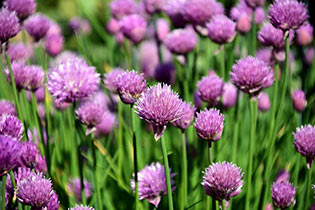What are Chives?
Chives are a very popular garnishing spice in French and Chinese cooking. The name “chives” is derived from the Latin word cepa , meaning onion , which later became cive in French. Called little onion in European languages, they are related to onion, leek, and garlic and used as spice or vegetable, depending on the region. Chives are native to Central Asia and now cultivated in Scandinavia, Germany, Britain, China, and Southeast Asia. There are many varieties from the West and the East. Chives are hollow, long, narrow stems attached to a bulb on one end and tube-shaped green leaves at the other. They are used fresh or dried. The light purplish flowers of chives have a light, delicate chivelike flavor. The entire length of the tubular leaf is used in foods. Chinese chives have flat and wider stems than regular varieties. The stems are bright green. Regular or onion chives have a mild, oniony flavor because of their sulfur content. They have a more delicate flavor than scallions. Chinese or garlic chives are slightly garlicky and stronger in flavor than the onion variety. The bulbs have a delicate onionlike flavor. They tend to lose most of their flavor through drying and when exposed to heat.
Chemical Components
The essential oil of chives consists mainly of dipropyl disulfide, methyl pentyl disulfide, and penthanethiol. They contain vitamin A, vitamin C, potassium, and folic acid.
 Cooking with Chives
Cooking with Chives
Chives are a popular ingredient in European cooking because of their delicate flavor. They are an essential flavoring of the spice blend, fines herbs
, that is commonly used in French cooking. The bright green leaves of chives are good as a garnish in cold salads, stews, and soups or when sprinkled over cooked sauces, soups, and finished meals. The finely chopped leaves and bulb are used to garnish vichyssoise, cheese and cream sauces, gravies, dips, and baked potatoes. Chinese chivesare chopped or sliced and are used as a common garnish for all dishes, stir-fried vegetables, fried noodles, fried rices, grilled meats, fish dishes, and dumpling fillings. Chives pair well with lemon, tarragon
, parsley
, sesame oil, vinegar, garlic, soy sauce, ginger
, potatoes, and chile peppers
. Their bulbs are also pickled. In the United States, chives are used in cottage cheese, egg dishes, cocktail sauces, dried soups, and sour cream. The Nepalese and Tibetans add it to dals and momos (dumplings). It is fried in butter fat to get a more intense flavor.
Spice Blends:remoulade blend, fines herbes
, dumpling sauce blend, and vichyssoise blend.
Health Benefits of Chives
Chives have been used to help lower blood pressure and aid digestion. They also stimulate the appetite and possess some antiseptic properties.
Other Names
Onion chives. They are also called warak basal (Arabic), manr sokh (Armenian), div chesun (Bulgarian), purlog (Danish), bieslook (Dutch), tareh (Farsi), civette/ciboulette (French), schnittlauch (German), praso (Greek), irit (Hebrew), erba cipollina (Italian), asatsuki (Japanese), cebolinha (Portuguese), lukrezanets (Russian), cebollino (Spanish), graslok (Swedish, Norwegian), and frenk sogani (Turkish). Chinese Chives: garlic chives, spring onions, kow choi (Cantonese), kuchai (Malaysian, Indonesian), jui tsai (Mandarin), jimbu (Nepalese), ku chai (Thai), and ka choy (Khmer).
Scientific Name
regular chives: Allium (A) schoenoprasum
garlic chives or Chinese chives: A. tuberosum
Nepalese chive or Himalaya onion: A. walchii.
Family: Alliaceae (onion family).
Image by Ulrike Leone from Pixabay



